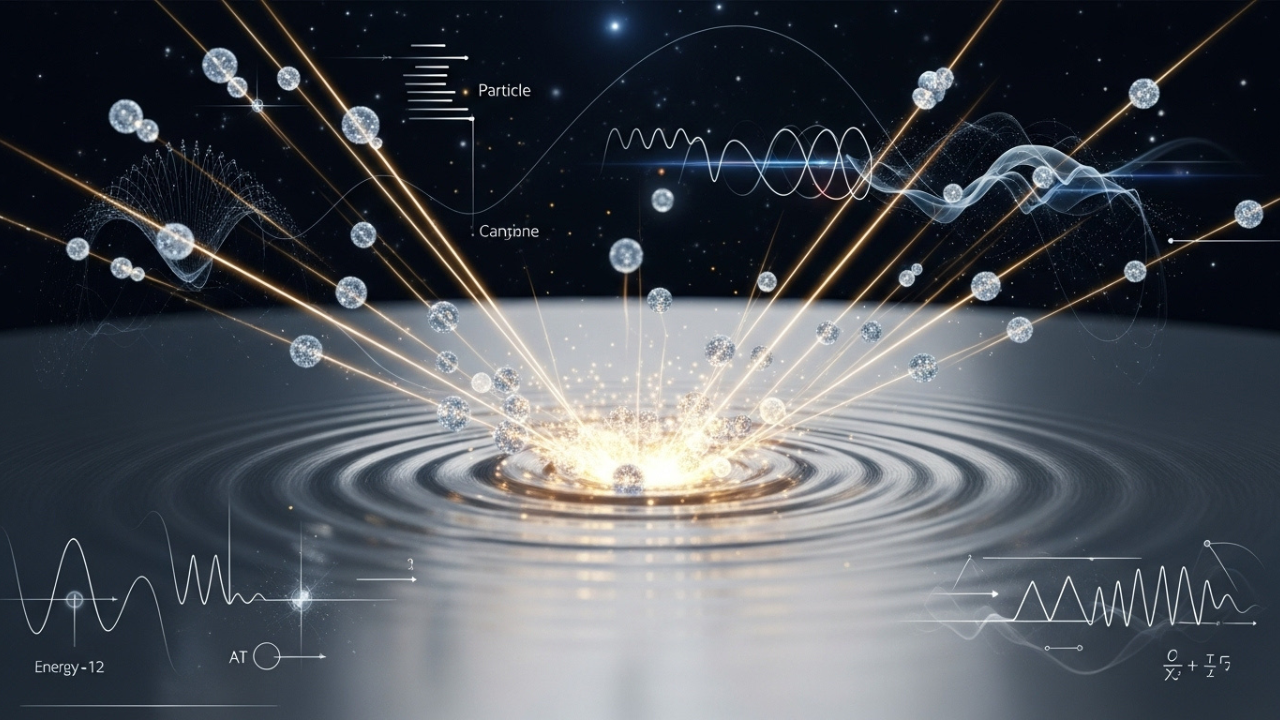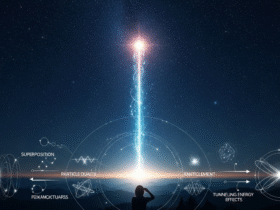There’s something captivating about seeing light interplay with metal. It’s delicate, unnoticeable, yet something very tangible takes place.
The first time I had the opportunity to see a digitally animated clip of light striking and breaching a smooth metallic surface, causing tiny particles to leave, stays with me.
It was as if I was witnessing the metaphysical mechanics of the cosmos through a telescope.
Before the clip, I believed light was something that could be turned on and off using a toggle button. However, there is plenty more.
What I’ve witnessed in the digital clip’s animation was a photoelectric effect in its full glory, and it ferreted out a realm of boundless possibilities where light defies logic.
Key Takeaways
The phenomenon of photoelectric effect proves the capacity of light to discharge electrons from metal, provided its frequency is sufficiently high.
All light is not qualified. Ejection of electrons is only barreled by sufficient photon energy. Lack of it fails to do the job.
With the introduction of photons in Einstein’s account, the solar system’s quantum anatomy was birthed.
Demonstrating with animations how energy is dispersed in collisions and bursts from a single photon beam directed at the electron is valuable.
The phenomenon governs the principles of immediate devices like solar panels detacted by light, as well as light-sensitive equipment stationed around you.
Why Bright Light Doesn’t Always Do What You Expect
Think about shining a strong flashlight on a metal sheet. You would focus a lot of intensity and energy towards it. Scientists believed that when they conducted their experiments, however, they were met with peculiar results. Regardless of the intensity of the light, it would never disengage the electrons from the metal without the light’s frequency being set to a specific threshold. Even if you attempted blasting a thousand candle’s worth of light, the electrons would remain locked. However, a minuscule incremental blue shift in frequency results in electrons being blasted off. This was proved unexplainable with classical physics.
What was happening? What prompted some light to have some effects, while for some, it instantly jettisoned electrons? A simulation of red low-frequency light striking a metal surface which did absolutely nothing and blue high-frequency light blasting tiny electrons added had virtually no difference. It becomes clearer: The amount of brightness photons emit (sprightly bouncing particles of light) makes a massive difference. The photoelectric effect starts making some sense.
Looking Beneath The Surface Of Metal
Before you can grasp what is happening, try imagining electrons spaced out at the surface of a metal. Something wakes them up from the slumber: Energy. This colossal amount pushes the metal surface a fragment, pristine fraction where the electrons would become orbiting.
Let us consider a photon now; the smallest packet of light. A photon possesses energy and can deliver a careful punch to any of the electrons. If the energy surpasses the “work function” of the metal, the electron will pop and escape into the ambient space. The lesser energy photons do not excite the electrons, hence they remain trapped. This phenomenon is called the photoelectric effect. The process of the effect is not gradual. There is no build up over time. Everything is achieved almost instantly and directly.
Bringing this to life through animation provides an understanding that no amount of formulas could provide. The sequence of events is crystal clear: photon arrival, collision with the electron, absorption of energy, and finally the electron spring-boarding off. That particular moment highlights the beauty of turning theory into imagery which makes the educational journey much more memorable.
The Moment Light Became Part Particle
The photoelectric effect sweepingly obliterated the notion that light was purely a wave in existence. For centuries, people tried to deduce whether light was composed of tiny particles or waves. Its capacity to bend, reflect, and diffract also makes it a wave. The photoelectric effect, however, needed a different explanation. If “light” could provide energy in parcels, and each parcel could eject an electron, then surely “light” must function like a particle – at least for this scenario.
Einstein gave a radical answer. he said light consisted of quantized packets later named photons which had energy proportional to their frequency. High frequency means high energy. Only when this energy is surpasses a certain limit can it set electrons free. At the time, his perception was radical, but it perfectly resolved the enigma. It also set the stage for quantum theory particles acting like waves and vice versa.
The animations of this procedure generally depict a light wave hitting the metal surface and converting into distinct particles. The ‘ bouncing dots’ animation that follows captures Einstein’s idea beautifully. You don’t require complex calculations to comprehend the concept. Simply witnessing that event allows one to understand that the light’s duality isn’t mystifying; rather, alons it’s a component of the narrative.
Why Frequency, Not Brightness, Is The Key
The mystery that confounded so many scientists prior to the acceptance of quantum concepts was this. According to classical theory, if one increases the light’s brightness, it leads to an increase in energy which in tern expels more electrons. Experiments proved otherwise. Bright low frequency light did nothing, and dim high frequency light did everything. The secret is not how much light is present, but rather, what type of light is present.
In animated simulations, one often observes red light being shown over a metal surface with photons seemingly reflecting off electrons rather harmlessly. Then you change to ultraviolet, and at two or four photons, electrons begin transforming into gas. This change is striking, and turns our instincts inside out. This emphasizes that electrons do rather care about the quality, not so much about quantity. You cannot coax them to shed off energy in light and retreat with an abundance of weaker light. There is a specific requirement of a high punch, and only photons of high frequency can offer such requirements.
Once this distinction becomes apparent, it is remarkably difficult to omit from memory. It teaches a more fundamental truth about the manner in which interactions occur. Not all aspects in personal life yield to the application of pressure. In some instances, what is significant is how well everything fits together, maybe alignment. And in the quantum realm, that alignment resolves to frequency.
How Einstein’s Idea Changed The World
Einstein’s rationale for why the photoelectric effect occurs awarded him the 1921 Nobel Prize. That alone suggests how vital the claim was. But beyond the accolades, his work illuminated a new perspective for the world. Instead of adhering to a single model to explain light, it was imperative to recognize nature could be more multifaceted, and astonishing than anything a single theory could encapsulate.
His observation marked the dawn of quantum mechanics, which later came to explain the phenomena of atomic energy and semiconductors. That’s all as a consequence of one small yet powerful observation, “some light, regardless of its brightness, lacks the energy required to electron motion.”
Such animations are not simply the illustration of previously discussed concepts, but the holistic depiction of them. This awakening is emblematic of higher learning; the instructional value does not stem from memorizing facts, rather recognizing patterns, formulating hypotheses and rationalizing unusual outcomes is the essence of science. That was Einstein’s approach, and every scientific animation automatically engages you step into the world of science.
From Theory to Technology You Can Hold
The photoelectric effect is more than just an interesting experiment; it serves as the basis of significant technology advancements. Solar panels, for instance, rely on this phenomenon to transform sunlight into energy. Each photon striking the solar panel can potentially liberate an electron, subsequently resulting in a current. However, this is only feasible when the sunlight is sufficiently energetic. This explains why solar panels operate more effectively with direct, intense sunlight rather than with subdued lighting.
Devices such as door sensors, calculators, and security devices also utilize the photoelectric effect. Light beams are directed towards a given surface, and when an object blocks that beam, there is a change in the electron flow. That alteration can be identified and transformed into a signal. In the absence of the photoelectric effect, these devices would not function. Additionally, complex concepts become simpler when one views animated diagrams illustrating every single process.
There’s a newfound understanding when one witnesses an animation that commences with sunlight streaming into the solar panel’s surface, electrons being set free, and ultimately current circulating through a circuit. Renders the scientific concept of converting light energy into stored energy quite literally accessible. Such advancements within education yield flourishing possibilities in learners’ lives beyond the intellectual scope.
When Electrons Move, Energy Moves
fundamentally, The photoelectric effect is focused on the transferring of energy from one object to another. There is a transfer of energy when an object moves. An electron receives energy from a photon. If it’s sufficient, the electron breaks free; if not, the system remains unchanged. And while this may sound simple, it actually marks the inception of quantum physics. It illustrates how single, separable interactions—a photon and an electron—can lead to something far more complex.
Animations that spotlight this particular type of interaction help to accomplish the perception of a personal touch. The viewer is actively engaged in observing unique moments rather than being bombarded by a sea of chaos. This brings them closer to the said theory. One can visualize the universe not merely as an energetic blur, but as the complex web of meaningful exchanges filled with defined, significant interactions. That is, arguably, the most powerful gift of a proper science education.
My Opinion
The reasoning underlying this claim is the marked difference between reading about a subject and reading something like the photoelectric effect explained using Advanced Animations. You don’t learn or read over a theory; instead, you witness it firsthand. Once that magic happens, you start questioning whether science is mere numbers and equations. Suddenly it becomes apparent that there is a narrative in which a secret exists within light, a metal holds its key, and one interaction is capable of setting everything free. The more one observes the world around them, the more it feels dynamic and makes sense.






























Leave a Reply
View Comments